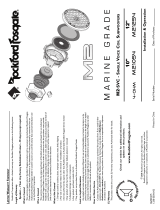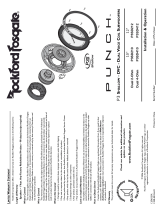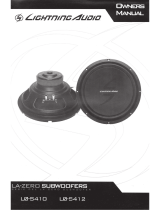
7
Empfohlene Gehäuse
DieseAnleitung beschreibt zwei spezifischeTypen von Gehäusen, die grundsätzlich ver-
schiedene Performancemerkmale bieten.DieserAbschnitt soll Ihnen dabei helfen zu
entscheiden,welcher der besteTyp für IhreAnwendung ist.
Geschlossene Gehäuse
Geschlossene Gehäuse lassen sich am leichtesten bauen.Der wichtigsteAspekt beim Bau
eines geschlossenen Gehäuses ist zu gewährleisten, dass es luftdicht ist. DieVerwendung
von Klebstoff und anderen Dichtungsmitteln an allen Fugen gewährleistet eine solide Kon-
struktion und verhindert Luftverlust.Das Gehäusevolumen wirkt sich unmittelbar auf die Per-
formance des Lautsprechers aus.Größere Gehäuse bieten eine flachere Reaktion und tiefere
Bässe,wohingegen kleinere Gehäuse eineAbweichung in der Reaktionskurve bieten und im
Allgemeinen durch höhere Leistung zu einem höheren Schalldruckpegel führen.
Vorteile von geschlossenen Gehäusen:
• Kleine Gehäuse
• Lineare (flache) Reaktion
• Keine Öffnungsgeräusche
• Hohe Nennbelastbarkeit in allen Frequenzbereichen
• Ausgezeichnete Klangqualität
Belüftete Gehäuse
Belüftete Gehäuse unterscheiden sich von geschlossenen Gehäusen nur in sofern, als dass
ein Luftschlitz bzw. eine Öffnung hinzugefügt wird, um das Gehäuse zu „stimmen“.Die emp-
fohlenen Gehäuse sind für hervorragende Gesamtperformance konstruiert.Größere Gehäuse
lassen sich in der Regel leichter auf niedrigere Frequenzen abstimmen,wohingegen sich mit-
tlere und kleine Gehäuse leichter auf höhere Frequenzen abstimmen lassen.Das belüftete
Design zeigt eine weniger lineare Reaktion als das geschlossene Gehäuse, erbringt jedoch
eine feststellbar höhere Leistung auf der abgestimmten Frequenz.
Vorteile von belüfteten Gehäusen:
• Höhere Durchschnittsleistung als geschlossene Gehäuse
• Abstimmfrequenz kann leicht durch Änderung der Öffnungslänge a gepasst werden
• Tiefes Bassverhalten bei geringerem Kraftbedarf
• Gut geeignet für hohe Leistung bei beschränkter Kraft
Bau des Gehäuses
Um ordnungsgemäß zu funktionieren,müssen die Gehäusewände steif sein und dürfen nicht
nachgeben,wenn sie dem hohen Druck ausgesetzt sind, der bei Betrieb des Lautsprechers
entsteht. Für optimale Performance empfehlen wir Faserplatte mittlerer Dichte (Stärke ca. 1,9
cm) und interneAussteifungen.Das Gehäuse wird verleimt und mit Nägeln oder Schrauben
befestigt.Da Faserplatte luftdurchlässig ist, wird geraten, das Gehäuse von außen mit Poly-
urethan zu behandeln.
Berechnung desVolumens
Zur Berechnung desVolumens einfach die Maße feststellen und folgende Formel anwenden:
Gehäuse-Volumen Höhe (cm) x Breite (cm) xTiefe (cm)
Vorbei geteilt (Liter) 1000
Sind zwei gegenüber liegende Seiten ungleich lang, die Durchschnittslänge der beiden
Seiten berechnen.DasVolumen lässt sich mithilfe dieser Zahl berechnen, ohne das Gehäuse
inAbschnitten berechnen zu müssen.Die Stärke des Resonanzwandmaterials reduziert das
Innenvolumen und muss daher zur Feststellung des Innenvolumens vomAußenvolumen
subtrahiert werden.Der Lautsprecher selbst reduziert das Innenvolumen ebenfalls.Die Luft-
verdrängung für jedes Modell ist unterTechnische Daten aufgeführt und muss bei der Gesa-
mtkalkulation desVolumens ebenfalls subtrahiert werden.
Verkabelungskonfigurationen
DurchVeränderung derVerkabelungskonfiguration Ihrer Lautsprecher können Sie eine Imped-
anzlast herstellen, die Ihrem System entspricht. Bietet dieVeränderung derVerkabelungskon-
figurationen eine Reihe von Optionen für die Impedanzlast. Reihen-, Parallel- oder Reihen-
Parallel-Verkabelungen sind verschiedeneTechniken für dieVerkabelung von Lautsprechern,
die unterschiedliche Belastungen bieten.Die Reihenkonfiguration ist eine Reihenmethode,
bei der die Lautsprecher von Ende zu Ende verkabelt werden.Die Parallelkonfiguration ver-
wendet mindestens zwei Lautsprecher, die über gemeinsameAnschlüsse verkabelt werden.
Die Reihen- Parallel-Konfiguration kombiniert beideTechniken.Wählen Sie das nachfolgende
Verkabelungsdiagramm aus, das der Zahl anTieftönern und der Impedanz Ihres Verstärkers
entspricht.
Subwoofer-Crossover
Es gibt zwei Betriebstypen für Crossover, und zwar passive und aktive. Passive Crossover
(Spulen oder Induktoren) werden auf den Lautsprecherkabeln zwischen Verstärker und
Lautsprecher platziert. Ein aktives Crossover ist ein elektronischer Filter, der dasAudiosignal
trennt, das verschiedenenVerstärkern zugeführt wird. Zur optimalen Subwoofer-Performance
empfehlen wir dieVerwendung von aktiven 80-100 Hz-Niedrigpass-Crossovern bei 12 dB/
Oktav.
Casse acustiche consigliate
Il presente manuale descrive a grandi linee due tipi di cassa acustica che forniscono prestazi-
oni distintamente diverse. La presente sezione mira ad aiutare a decidere quale sia il tipo
migliore per la propria applicazione.
Casse a chiusura ermetica
Le casse a chiusura ermetica sono le più semplici da costruire. La cosa più importante in
questo tipo di costruzione è di accertarsi che la chiusura sia a tenuta d’aria. L’uso di colla
e di un qualche altro tipo di mastice in tutti i punti di giuntura garantirà che la costruzione
sia solida ed eviterà le perdite d’aria. Il volume della cassa influirà in modo diretto sulle
prestazioni del diffusore. Le casse più grandi forniranno una risposta più piatta e bassi più
profondi, mentre quelle più piccole presenteranno una gobba nella curva di risposta e forni-
ranno in generale un’uscita più alta per un maggiore livello SPL.
Vantaggi delle casse a chiusura ermetica:
• Casse di dimensioni ridotte
• Risposta lineare (piatta)
• Nessun disturbo da apertura
• Gestione di potenza alta a tutte le frequenze
• Eccellente qualità del suono
• Ottima uscita di bassa frequenza a confronto delle casse con sfiato
Casse con sfiato
Le casse con sfiato differiscono da quelle a chiusura ermetica solo per il fatto che in esse è
praticata un’apertura o porta per “accordare” la cassa stessa. Le casse consigliate sono state
progettate per fornire una buona prestazione nell’insieme. Le casse più grandi sono gener-
almente più facili da accordare alla frequenze più basse, mentre quelle piccole e di misura
mediana sono più facili da accordare alle frequenze più alte. Il design con sfiato ha risposta
meno lineare delle casse a chiusura ermetica, ma possiede un’uscita notevolmente maggiore
alla frequenza di accordo.
Vantaggi delle casse con sfiato:
•Uscita media superiore alle casse chiuse
• La frequenza di accordo può essere regolata facilmente modificando la lunghezza
dell’apertura
• Risposta di bassi profondi con minore potenza
• Ottime per uscita alta con potenza limitata
Costruzione della cassa
Perché la cassa possa funzionare in modo corretto è necessario che le pareti siano rigide e
non si flettano quando sono assoggettate alle alte pressioni prodotte dal diffusore in opera-
zione. Per ottenere i migliori risultati si consiglia di usare MDF (pannello di fibre di densità
media) dello spessore di 3/4 di pollice. I pannelli della cassa dovrebbero essere uniti con
colla e tenuti assieme in modo sicuro con chiodi o viti.
Calcolo del volume
Il calcolo del volume consiste semplicemente nel prendere le misure in pollici e usare la
formula seguente:
Volume della casella
Altezza(cm) x Larghezza (cm) x Profondità
(cm)
Diviso vicino (nei litri) 1000
Se due lati hanno lunghezze diverse, sommare i due valori e dividere per due per ottenere il
valore medio. Il numero così ottenuto fornirà il volume senza doverlo calcolare dividendo la
cassa in sezioni e quindi sommando assieme i volumi delle diverse sezioni. Lo spessore del
materiale di diaframma riduce il volume interno e quindi lo si dovrà sottrarre alle dimensioni
esterne per calcolare il volume. Anche l’altoparlante vero e proprio riduce il volume interno.
Il volume d’aria occupato da ciascun modello è indicato nel foglio dei dati tecnici e dovrà
essere sottratto dal volume lordo calcolato.
Configurazione d’impianto
Variando la configurazione d’impianto dei propri diffusori si può creare un carico d’impedenza
accoppiato a quello del sistema. La modifica della configurazione d’impianto produce una
gamma di scelte di carico d’impedenza. Le configurazioni d’impianto in serie, in parallelo, in
serie-parallelo rappresentano diverse tecniche di collegamento dei fili che producono carichi
diversi. La configurazione in serie rappresenta un metodo di collegamento in cui i diffusori
sono collegati uno dopo l’atro. La configurazione in parallelo utilizza due o più diffusori
collegati con terminali comuni. La configurazione in serie-parallelo unisce le due tecniche.
Scegliere lo schema d’impianto che corrisponde al proprio numero di woofer e all’impedenza
dell’amplificatore.
Crossover dei subwoofer
Ci sono due tipi di crossover, passivo e attivo. I crossover passivi (bobine o induttori) sono
posti sui fili dei diffusori tra il diffusore e l’amplificatore. Il crossover attivo è un filtro elettro-
nico che separa il segnale audio inviato a diversi amplificatori. Per ottimizzare le prestazioni
dei subwoofer, si consiglia di usare un crossover attivo passa-basso da 80-100 Hz a 12 dB/
ottava.
ItalianoDeutsch

















